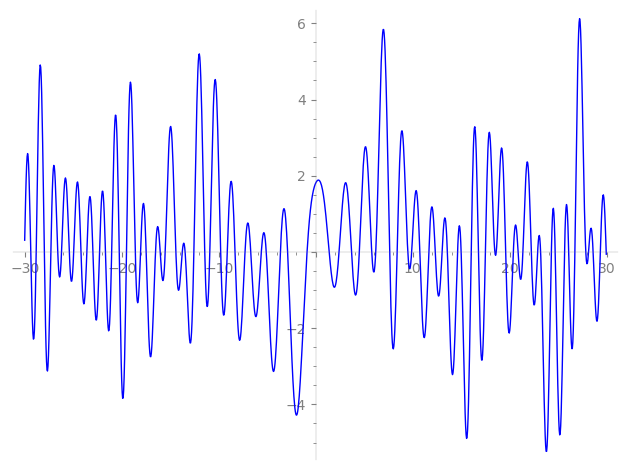| L(s) = 1 | + (0.309 + 0.951i)2-s + (−0.809 + 0.587i)4-s + (0.951 + 0.309i)5-s + (−0.616 − 0.848i)7-s + (−0.809 − 0.587i)8-s + 0.999i·10-s + (−0.415 − 3.29i)11-s + (3.02 − 0.983i)13-s + (0.616 − 0.848i)14-s + (0.309 − 0.951i)16-s + (1.53 − 4.73i)17-s + (4.00 − 5.51i)19-s + (−0.951 + 0.309i)20-s + (3.00 − 1.41i)22-s + 3.07i·23-s + ⋯ |
| L(s) = 1 | + (0.218 + 0.672i)2-s + (−0.404 + 0.293i)4-s + (0.425 + 0.138i)5-s + (−0.233 − 0.320i)7-s + (−0.286 − 0.207i)8-s + 0.316i·10-s + (−0.125 − 0.992i)11-s + (0.839 − 0.272i)13-s + (0.164 − 0.226i)14-s + (0.0772 − 0.237i)16-s + (0.373 − 1.14i)17-s + (0.918 − 1.26i)19-s + (−0.212 + 0.0690i)20-s + (0.639 − 0.301i)22-s + 0.640i·23-s + ⋯ |
\[\begin{aligned}\Lambda(s)=\mathstrut & 990 ^{s/2} \, \Gamma_{\C}(s) \, L(s)\cr =\mathstrut & (0.990 - 0.134i)\, \overline{\Lambda}(2-s) \end{aligned}\]
\[\begin{aligned}\Lambda(s)=\mathstrut & 990 ^{s/2} \, \Gamma_{\C}(s+1/2) \, L(s)\cr =\mathstrut & (0.990 - 0.134i)\, \overline{\Lambda}(1-s) \end{aligned}\]
Particular Values
| \(L(1)\) |
\(\approx\) |
\(1.80581 + 0.121854i\) |
| \(L(\frac12)\) |
\(\approx\) |
\(1.80581 + 0.121854i\) |
| \(L(\frac{3}{2})\) |
|
not available |
| \(L(1)\) |
|
not available |
\(L(s) = \displaystyle \prod_{p} F_p(p^{-s})^{-1} \)
| $p$ | $F_p(T)$ |
|---|
| bad | 2 | \( 1 + (-0.309 - 0.951i)T \) |
| 3 | \( 1 \) |
| 5 | \( 1 + (-0.951 - 0.309i)T \) |
| 11 | \( 1 + (0.415 + 3.29i)T \) |
| good | 7 | \( 1 + (0.616 + 0.848i)T + (-2.16 + 6.65i)T^{2} \) |
| 13 | \( 1 + (-3.02 + 0.983i)T + (10.5 - 7.64i)T^{2} \) |
| 17 | \( 1 + (-1.53 + 4.73i)T + (-13.7 - 9.99i)T^{2} \) |
| 19 | \( 1 + (-4.00 + 5.51i)T + (-5.87 - 18.0i)T^{2} \) |
| 23 | \( 1 - 3.07iT - 23T^{2} \) |
| 29 | \( 1 + (4.48 - 3.26i)T + (8.96 - 27.5i)T^{2} \) |
| 31 | \( 1 + (-2.84 - 8.75i)T + (-25.0 + 18.2i)T^{2} \) |
| 37 | \( 1 + (-3.29 + 2.39i)T + (11.4 - 35.1i)T^{2} \) |
| 41 | \( 1 + (-4.76 - 3.46i)T + (12.6 + 38.9i)T^{2} \) |
| 43 | \( 1 + 12.0iT - 43T^{2} \) |
| 47 | \( 1 + (5.54 - 7.62i)T + (-14.5 - 44.6i)T^{2} \) |
| 53 | \( 1 + (-5.42 + 1.76i)T + (42.8 - 31.1i)T^{2} \) |
| 59 | \( 1 + (7.87 + 10.8i)T + (-18.2 + 56.1i)T^{2} \) |
| 61 | \( 1 + (-10.0 - 3.25i)T + (49.3 + 35.8i)T^{2} \) |
| 67 | \( 1 - 2.33T + 67T^{2} \) |
| 71 | \( 1 + (1.84 + 0.599i)T + (57.4 + 41.7i)T^{2} \) |
| 73 | \( 1 + (-4.69 - 6.46i)T + (-22.5 + 69.4i)T^{2} \) |
| 79 | \( 1 + (-0.413 + 0.134i)T + (63.9 - 46.4i)T^{2} \) |
| 83 | \( 1 + (3.36 - 10.3i)T + (-67.1 - 48.7i)T^{2} \) |
| 89 | \( 1 - 9.72iT - 89T^{2} \) |
| 97 | \( 1 + (4.62 + 14.2i)T + (-78.4 + 57.0i)T^{2} \) |
| show more | |
| show less | |
\(L(s) = \displaystyle\prod_p \ \prod_{j=1}^{2} (1 - \alpha_{j,p}\, p^{-s})^{-1}\)
Imaginary part of the first few zeros on the critical line
−9.797687338639150938798396365452, −9.120437419006225810676834882442, −8.317477107108648855074453394335, −7.28820911654029960765576911182, −6.69549150120790903462442696825, −5.60790935687928709172325592689, −5.10015818971306778933544342747, −3.64733211146744671824360631719, −2.89831921503144670880186009050, −0.894330298922593197628374670739,
1.38717245243940177141748668170, 2.40406276793444630286026818026, 3.68984516933048004074395333347, 4.49203520087696066931502156971, 5.77295667794549376157427143508, 6.18471852595038378596564553669, 7.61436351536474667705563611758, 8.393742730136391010409987049746, 9.493502134498385973439570847032, 9.888150742194946414342785952859

